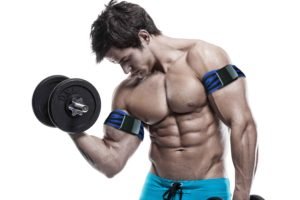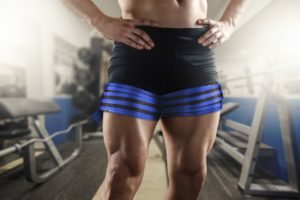Basic Guide to Blood Flow Restriction Training
Occlusion training (Blood Flow Restriction) has been making the rounds in the fitness world.
The idea behind this form of training is restricting blood flow to the muscle. You place a wrap around your arms and/or legs. By doing this you allow the blood to enter the muscle via your arteries, but you restrict the blood from leaving via the veins.
The advantage of this training is two-fold. First, it causes a buildup of metabolites in the muscle. Specifically, lactic acid which has been shown to stimulate muscle growth. This is the “pump” feeling you get when you work out. Second, this type of training fatigues your nervous system forcing your body to recruit your fast twitch muscle fibers. These are the fibers with the greatest growth potential.
Basic Guide to Blood Restriction Training
The Wraps
The most important part of the training is having the correct wraps. As I said above, the goal is to allow blood flow to the muscle but slow blood from leaving the muscle. We are trying to close the veins, but not close the arteries.
The width of the wraps play a significant role. Narrow is better than wide. The wider the wraps the greater the chance of blocking the arteries. You want to use a wrap that is 5-8 cm. These are the wraps I use.
Placement
It is easier to look at pictures.


Pressure
If you have the wraps too tight you risk blocking both the veins and the arteries. Doing this will remove any benefit from this type of training. There is no exact science for how tight the wraps should be, but we have a subjective idea.
The goal should be a 7 out of 10 pressure on the legs and a 6 out of 10 pressure on the arms. 0 would be no pressure and 10 would be as tight as possible. If you are unsure about the pressure it is best to err on the side of caution and have less pressure. A 5 out of 10 is better than a 9 out of 10.
Sample Workout
Ok. You have the bands set up.
What now?
You will quickly find out that working out with wraps is dramatically different. Try a few curls. You will feel the “pump” almost instantly.
Because of the wraps we are going to train at about 30-50% of your 1RM (1 rep max). That means if you can curl 50 lbs you will work with 25 lb dumbbells or lower. With the smaller weights we are going to be working with higher rep ranges, 10-25 reps per set. Finally, isolation exercises are better than compound exercises (leg extensions instead of squats).
Only wrap one part of the body at a time. If you are doing leg exercises do not wrap your arms and vice versa.
Whole Body Workout Sample
# Exercise Sets Reps Rest
A1 Leg Extension 3 15 30 - 60 secs
A2 Leg Curls 3 15 30 - 60 secs
A3 Calf Raises 3 15 30 - 60 secs
B1 Bicep Curls 3 15 30 - 60 secs
B2 Tricep Pressdowns 3 15 30 - 60 secs
You complete all the A’s before moving on the the B’s
The workout may look simple, but trust me. Occlusion training will be one of the hardest workouts you do. Remember to choose a weight 30-50% of your 1RM.
Occlusion Training is an exciting new development. I do not think it is a requirement to do this type of training, but it is a nice supplemental option. It is great if you do not have access to heavier weights or are traveling and have limited options.
Go ahead give it a try. It’s a nice way to variety to your workout regimen.
great job with this post! perhaps you will find this intresting? https://steemit.com/steemit/@enki74/looking-for-a-diet-that-will-heal-detox-liver-de-calcify-the-body
great work-out tips ; upvoted followed.
Appreciate it!
You're welcome.